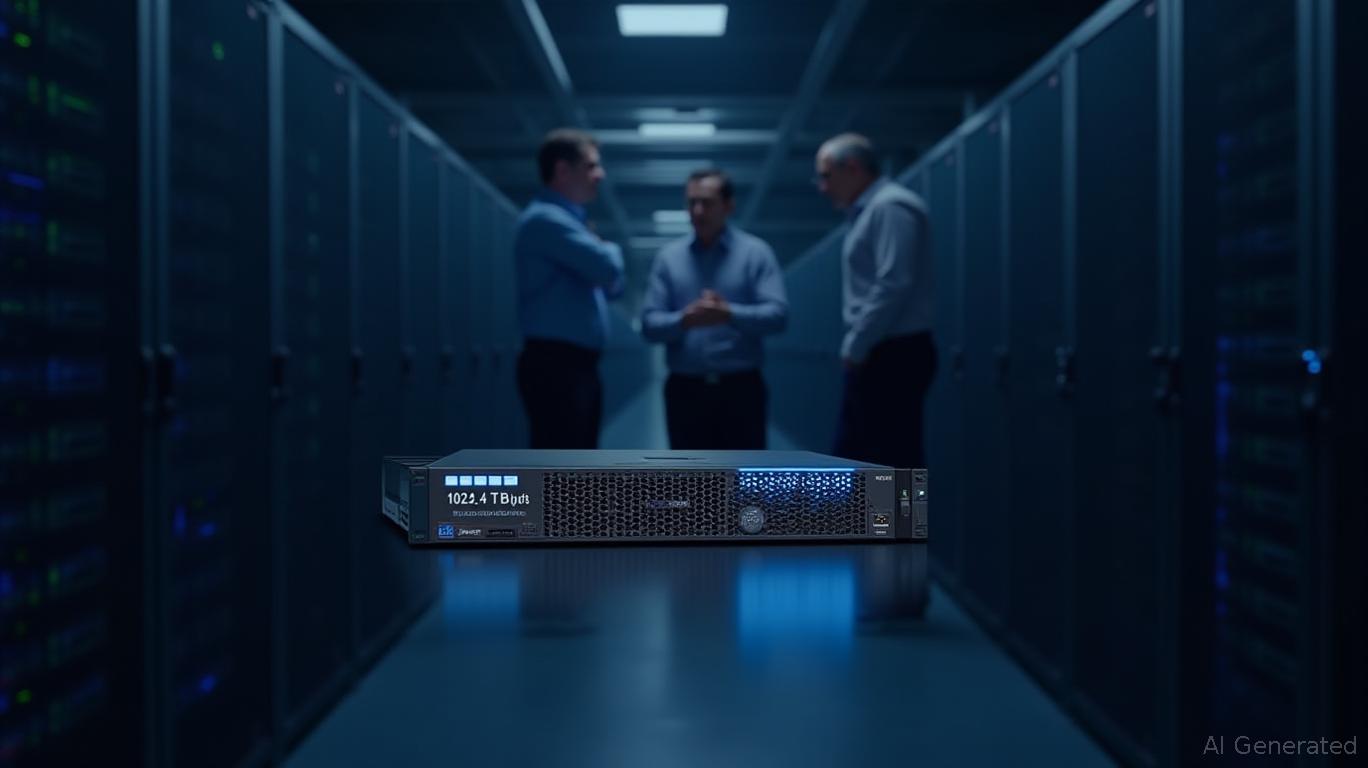Broadcom (AVGO): The AI Infrastructure Play with Exponential Upside
The race to build the next-generation AI datacenter is intensifying, and
(AVGO) stands at the epicenter of this transformation. With its Q2 FY2025 results showcasing 20% year-over-year revenue growth to $15 billion, driven by AI semiconductors and infrastructure software, the company has cemented its position as a critical enabler of the AI boom. While valuation concerns linger, Broadcom's strategic dominance in networking, custom accelerators (XPUs), and VMware integration creates a compelling narrative for long-term investors. Let's dissect why this could be a multi-year winner—and why caution is still warranted.The AI Infrastructure Boom & Broadcom's Unique Position
Broadcom's strength lies in its ability to address two core challenges of modern AI datacenters: networking bottlenecks and compute acceleration. Its Tomahawk 6 switch, launched earlier this year, delivers 102.4 terabits/sec of switching capacity—double the prior generation—while supporting AI clusters with over one million XPUs. This product is a game-changer for hyperscalers, as it reduces latency and scales bandwidth to handle exponential data flows.

Beyond hardware, Broadcom's XPUs (accelerators) are quietly reshaping the AI chip landscape. While NVIDIA dominates the GPU market, Broadcom's accelerators complement GPUs by optimizing tasks like data routing and model training. Its three major hyperscaler customers—likely Google, Amazon, and Microsoft—are on track to deploy 1 million XPUs each by 2027. With four more hyperscalers in advanced trials, the addressable market for these chips could balloon to $60–$90 billion by 2027, creating a flywheel effect for Broadcom's AI semiconductor revenue.
Hyperscaler Partnerships & the VMware Flywheel
The synergy between Broadcom's networking and software assets is its secret weapon. The $67 billion VMware acquisition, completed in 2024, has proven transformative. VMware's Cloud Foundation (VCF) subscription model is driving 25% YoY growth in infrastructure software revenue, with 87% of the top 10,000 enterprises now adopting VCF. This recurring revenue stream—paired with the shift to private clouds—ensures steady cash flows even as public cloud growth slows.
Meanwhile, hyperscalers are doubling down on Broadcom's XPUs to build their own custom AI infrastructure. Unlike NVIDIA, which sells off-the-shelf GPUs, Broadcom collaborates with hyperscalers to design purpose-built accelerators. This “white-label” approach locks in long-term partnerships and shields Broadcom from price competition.
Financials: Profitability at Scale
Broadcom's Q2 results underscore its operational excellence:
- Operating profit rose 75% YoY to $5.8 billion, with non-GAAP net profit up 134% to $7.79 billion.
- Gross margins hit 79.4%, reflecting cost-cutting post-VMware integration.
- R&D spending (17% of revenue) targets next-gen Tomahawk switches (aiming for 3.2 Tbps by 2027) and AI accelerators.
The company returned $7 billion to shareholders in Q2 via dividends and buybacks, signaling confidence in its cash flow. Management raised Q3 revenue guidance to $15.8 billion (21% YoY), with AI semiconductor revenue expected to jump 60% YoY to $5.1 billion.
The Bull Case: Why PE Expansion Could Surprise
At first glance, Broadcom's stock (currently ~$247) appears pricey. A discounted cash flow (DCF) model suggests fair value around $208, implying a 15% premium. However, this ignores two catalysts:
1. Market Share Gains: Broadcom holds ~40% of AI-related networking revenue (up from 30% historically) and is the #2 AI chip player behind NVIDIA. Its niche focus on accelerators avoids direct GPU competition.
2. VMware's Recurring Revenue: VCF's subscription model reduces revenue volatility, making Broadcom's earnings more predictable and attractive to institutional buyers.
If the AI TAM hits $90 billion by 2027, and Broadcom captures 20–30% of that (via XPUs and networking), its AI segment alone could generate $18–27 billion in annual revenue—up from $4.4 billion today. This growth could justify a higher P/E multiple, especially if margins stay robust.
Risks & Near-Term Headwinds
No investment is without risks. Key concerns include:
- Geopolitical Exposure: 30% of Broadcom's manufacturing occurs in China, exposing it to tariffs or export restrictions. Management has flagged this as a “major uncertainty.”
- Non-AI Declines: Legacy semiconductor segments (e.g., consumer electronics) fell 5% YoY, though enterprise networking saw sequential improvement.
- Valuation Overshooting: At ~$247, the stock is trading above most analysts' targets. A pullback to $180–$200 could create a better entry point.
Investment Thesis: A Buy With a Margin of Safety
Broadcom's strategic moves in AI infrastructure and VMware integration are undeniably compelling. Its TAM expansion, recurring revenue streams, and R&D roadmap suggest it's well-positioned to capitalize on the AI datacenter boom for years. However, investors should:
- Wait for a pullback: The stock is near all-time highs; a drop to $175–$185 (closer to the $208 DCF target) would improve risk/reward. Historical performance shows buying on earnings announcement dates and holding for 20 days since 2020 would have yielded an average return of 15.93%, though with a maximum drawdown of -26.56%, underscoring the need for patience and risk management.
- Monitor hyperscaler trials: The four new hyperscaler partnerships could expand the TAM beyond current estimates.
- Watch geopolitical risks: China-related supply chain issues could disrupt margins if unresolved.
For long-term investors, Broadcom's blend of AI leadership, software synergies, and recurring revenue makes it a top pick in the infrastructure space—provided you buy at the right price.
Final Take: Broadcom is a strategic winner in the AI era, but valuation and macro risks require patience. A buy at $180–$200, paired with a focus on hyperscaler execution, could yield outsized returns over 3–5 years.

Comments
No comments yet